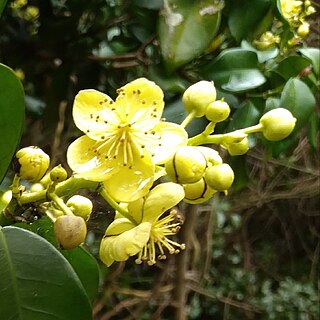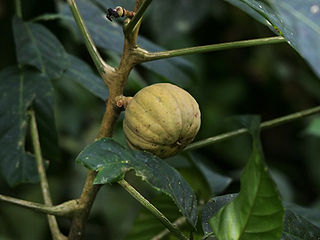Pachystroma is a monotypic plant genus in the family Euphorbiaceae first described as a genus in 1865. It is the only genus of its tribe (Pachystromateae). The only known species is Pachystroma longifolium, native to Brazil, Bolivia and Peru.
Mareya is a plant genus of the family Euphorbiaceae, first described as a genus in 1860. It is native to tropical western and central Africa.
Mareyopsis is a plant genus of the family Euphorbiaceae first described as a genus in 1919. It is native to western and central Africa.
- Mareyopsis longifolia(Pax) Pax & K.Hoffm. - Nigeria, Cameroon, Gabon, Equatorial Guinea, Congo-Brazzaville, Zaire
- Mareyopsis oligogynaBreteler - Gabon
Aparisthmium is a plant genus of the family Euphorbiaceae first described as a genus in 1840. It contains only one known species, Aparisthmium cordatum, native to South America and Costa Rica.
Caryodendron is a plant genus of the family Euphorbiaceae first described as a genus in 1860. The genus includes C. orinocense, known as the Inchi tree or Tacay nut. It is native to Central America and South America. They are dioecious trees.
- Caryodendron amazonicumDucke - Amazonas in Brazil
- Caryodendron angustifoliumStandl. - Costa Rica, Panama, Colombia
- Caryodendron janeirenseMüll.Arg. - Rio de Janeiro
- Caryodendron orinocenseH.Karst - Colombia, Venezuela, Ecuador
Cheilosa is a monotypic plant genus of the family Euphorbiaceae first described as a genus in 1826. Only one species is recognized: Cheilosa montana, native to Southeast Asia.
Philyra is a plant genus of the family Euphorbiaceae first described as a genus in 1841. It contains only one known species, Philyra brasiliensis, native to Brazil, Paraguay, and northeastern Argentina.
Astrococcus is a genus of plant of the family Euphorbiaceae first described as a genus in 1854. It contains only one known species, Astrococcus cornutus, native to neighboring states of identical names, Amazonas State in southern Venezuela and Amazonas State in northwestern Brazil.
Droceloncia is a genus of plant of the family Euphorbiaceae first described as a genus in 1959. It contains only one known species, Droceloncia rigidifolia, native to Madagascar and to the nearby island of Mayotte.
Adenocline is a genus of plants, under the family Euphorbiaceae first described as a genus in 1843. It is native to southern Africa.
- Adenocline acuta(Thunb.) Baill. - Malawi, Zimbabwe, Cape Province
- Adenocline paucifloraTurcz. - KwaZulu-Natal, Cape Province
- Adenocline violifolia(Kunze) Prain - Cape Province
Benoistia is a genus of shrubs or trees of the spurge family (Euphorbiaceae) and the monotypic subtribe Benoistiinae. It was first described as a genus in 1939. The entire genus is endemic to Madagascar. It is dioecious.
- Benoistia orientalisRadcl.-Sm. - N + E Madagascar
- Benoistia perrieriH.Perrier & Leandri - Madagascar
- Benoistia sambiranensisH.Perrier & Leandri - N Madagascar

Cavacoa is a plant genus of the family Euphorbiaceae first described as a genus in 1955. All the species are native to sub-Saharan Africa. It is dioecious.
- Cavacoa aurea(Cavaco) J.Léonard - Kenya, Malawi, Mozambique, KwaZulu-Natal
- Cavacoa baldwinii(Keay & Cavaco) J.Léonard - Sierra Leone, Liberia
- Cavacoa quintasii(Pax & K.Hoffm.) J.Léonard - Annobón, São Tomé, Zaïre
Neoboutonia is a plant genus of the family Euphorbiaceae first described as a genus in 1864. It is the only genus in subtribe Neoboutoniinae, and native to tropical Africa. It is dioecious.
- Neoboutonia macrocalyx Pax - Burundi, Cameroon, Rwanda, Zaire, Kenya, Tanzania, Uganda, Malawi, Zambia, Zimbabwe
- Neoboutonia manniiBenth. & Hook.f. - tropical Africa from Liberia to Mozambique
- Neoboutonia melleri(Müll.Arg.) Prain - tropical Africa from Nigeria to Mozambique

Hura is a genus of trees in the family Euphorbiaceae described by Carl Linnaeus in 1753. It is native to South America, Mesoamerica, and the West Indies.
Anthostema is a flowering plant genus in the Family Euphorbiaceae first described as a genus in 1824. It is native to Africa and Madagascar.
- Anthostema aubryanumBaill. - W + C Africa from Ivory Coast to Cabinda
- Anthostema madagascarienseBaill. - Madagascar
- Anthostema senegalenseA.Juss. - W Africa from Senegal to Benin
Ophellantha is a genus of plants under the family Euphorbiaceae first described as a genus in 1924. It is native to southern Mexico and northern Central America.
- Ophellantha spinosaStandl. - Honduras, El Salvador, Chiapas, Veracruz
- Ophellantha steyermarkiiStandl. - Guatemala, Chiapas
Adenopeltis is a plant genus of the family Euphorbiaceae first described as a genus in 1832. Its name comes from Greek and means "glandular shield". It contains only one known species, Adenopeltis serrata, endemic to the central part of the Republic of Chile in South America.
Dalembertia is a plant genus of the family Euphorbiaceae first described as a genus in 1858. It is native to Mexico and Guatemala.
- Dalembertia hahnianaBaill. - México State, Morelos, Michoacán
- Dalembertia platanoidesBaill. - Oaxaca, Guerrero, México State
- Dalembertia populifoliaBaill. - from Sonora to Oaxaca
- Dalembertia triangularisMüll.Arg. - Guatemala, Chiapas, Oaxaca
Leptonema is a genus of flowering plant belonging to the family Phyllanthaceae first described in 1824. The entire genus is endemic to Madagascar. It is dioecious, with male and female flowers on separate plants.
- Leptonema glabrum(Leandri) Leandri
- Leptonema venosum(Poir.) A.Juss.
Aubletiana is a plant genus of the family Euphorbiaceae, first described as a genus in 2000. It is native to tropical Africa.
- Aubletiana leptostachys(Breteler) J.Murillo - Cameroon, Gabon
- Aubletiana macrostachys(Breteler) J.Murillo - Gabon

